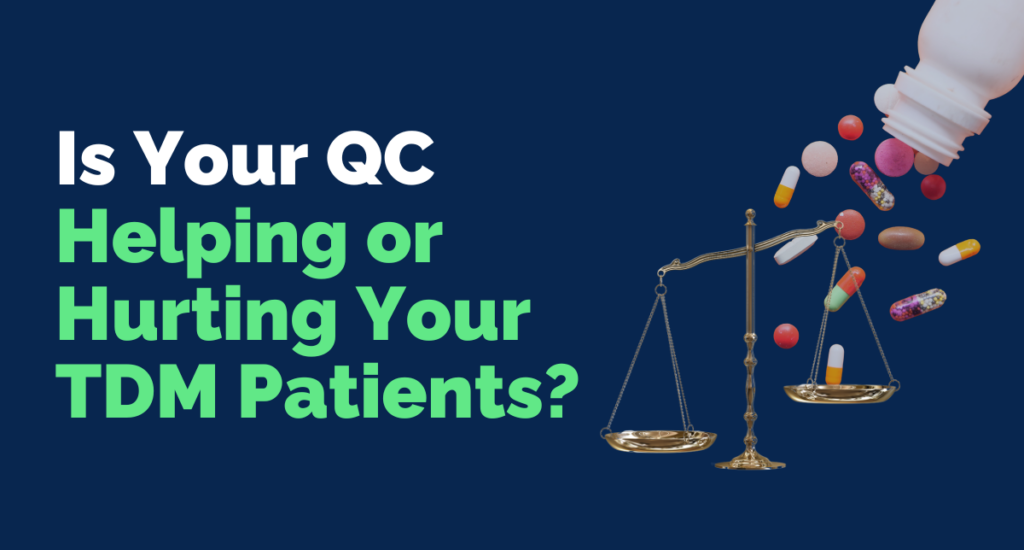
When “Close Enough” Isn’t Good Enough: The Risk to Patients
Therapeutic Drug Monitoring (TDM) exists because small deviations in drug concentrations can have significant consequences. For drugs with narrow therapeutic windows, such as digoxin, lithium, or tacrolimus, minor discrepancies between the actual and measured concentration can lead to underdosing resulting in ineffective therapy or overdosing causing toxicity.
A 2023 review highlighted that assay inconsistencies can negatively affect clinical decisions, drug adjustments, and patient outcomes, emphasizing the importance of reliable quality control practices in TDM (Lennernäs, 2023).
Endogenous matrix effects, such as binding proteins, clotting factors, or interfering metabolites, are particularly challenging for immunoassays and LC-MS/MS methods used in TDM. If control materials do not mimic true patient samples, they risk producing misleading results that clinicians may unknowingly act upon.
The CLSI EP07 guideline explicitly warns against using poorly matched control materials for matrix-sensitive analytes, stating that these materials “must closely resemble the clinical specimen to yield valid performance assessments” (CLSI, EP07-A2, 2021).
Reruns, Downtime, Delays: The True Cost of Suboptimal QC
Beyond the clinical implications, labs can experience a significant operational burden from suboptimal QC materials. Failing QC events often prompt full-day instrument downtimes, repeated calibration checks, and reruns that consume both reagents and staff hours. According to a 2022 AACC publication, 41% of laboratories reported that QC failures were the number one source of preventable workflow disruptions in their TDM pipelines (AACC, 2022).
Labs producing in-house controls face additional burdens such as sourcing human matrices, preparing and spiking analytes, and validating stability. The margin for error is high, especially in the aliquoting, labeling, and storage phases, which can introduce vial-to-vial inconsistencies or false confidence in the QC result. In contrast, third-party controls, designed independently of any one system, more accurately reflect patient sample behavior and are better equipped to flag performance deviations before they become clinical issues.
From Cost-Saving to Compliance Crisis: The In-House QC Gamble
On the surface, in-house QC might appear cost-effective. But when factoring in technician time, material waste from failed batches, reruns due to inconsistent controls, and possible regulatory noncompliance, the cost savings disappear quickly. According to Lab Manager’s 2021 Purchasing Trends Survey, laboratories prioritize product value and long-term efficiency in their purchasing decisions, reflecting concerns over the hidden costs associated with in-house QC practices. (Lab Manager, 2021).
Although direct peer-reviewed cost comparisons between in-house and third-party QC are limited, evidence from vendor-independent white papers and government best practices suggest that standardized QC materials enhance accuracy and compliance with federal regulations, such as CLIA and ISO 15189, both of which require traceable and reproducible performance verification (CMS.gov, ISO.org).
Inaccurate QC not only risks CLIA or CAP noncompliance but also complicates audit trails. Third-party controls that include lot-specific Certificates of Analysis (CoAs), cross-platform commutability data, and validated stability ranges are increasingly viewed as essential tools for meeting these regulatory expectations. This is especially true for labs seeking ISO 15189 accreditation, which requires demonstrable traceability and performance verification of all QC materials.
Given the high clinical stakes, operational risks, and regulatory pressures associated with TDM testing, relying on poorly matched or internally produced controls can cost more than just time and money, it can compromise patient health.
When Accuracy Matters, UTAK Delivers Confidence
That’s where UTAK’s Custom Quality Controls come in.
Our TDM controls are built with 100% REAL™ human matrices, designed to reflect patient samples for the most accurate performance verification possible. Whether you’re monitoring lithium, digoxin, tacrolimus, or other high-risk therapeutics, UTAK delivers:
- Matrix-matched materials for better method compatibility
- Lot-specific CoAs
- Custom concentration levels tailored to your testing thresholds
- Optional verification of requested analytes and their performance
Don’t let your controls be the weak link in your TDM testing. Choose precision that’s built for your patients, your instruments, and your compliance needs.
View Our TDM Product Line to discover matrix-matched controls that deliver confidence, compliance, and clinical accuracy.
